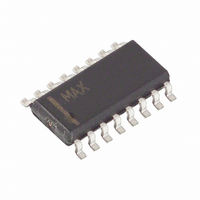MAX1653ESE Maxim Integrated Products, MAX1653ESE Datasheet - Page 20

MAX1653ESE
Manufacturer Part Number
MAX1653ESE
Description
IC CTRLR DCDC PWM STPDWN 16-SOIC
Manufacturer
Maxim Integrated Products
Type
Step-Down (Buck)r
Datasheet
1.MAX1655ESE.pdf
(28 pages)
Specifications of MAX1653ESE
Internal Switch(s)
No
Synchronous Rectifier
Yes
Number Of Outputs
1
Voltage - Output
2.5 ~ 5.5 V
Current - Output
10A
Frequency - Switching
150kHz, 300kHz
Voltage - Input
4.5 ~ 30 V
Operating Temperature
-40°C ~ 85°C
Mounting Type
Surface Mount
Package / Case
16-SOIC (3.9mm Width)
Power - Output
696mW
Output Voltage
2.5 V to 5.5 V
Output Current
10 A
Input Voltage
4.5 V to 30 V
Mounting Style
SMD/SMT
Maximum Operating Temperature
+ 85 C
Minimum Operating Temperature
- 40 C
Lead Free Status / RoHS Status
Contains lead / RoHS non-compliant
Available stocks
Company
Part Number
Manufacturer
Quantity
Price
Company:
Part Number:
MAX1653ESE
Manufacturer:
MAXIM
Quantity:
126
Company:
Part Number:
MAX1653ESE
Manufacturer:
MAXIM
Quantity:
9
Part Number:
MAX1653ESE
Manufacturer:
MAXIM/美信
Quantity:
20 000
Company:
Part Number:
MAX1653ESE+
Manufacturer:
Maxim
Quantity:
50
Part Number:
MAX1653ESE+
Manufacturer:
MAXIM/美信
Quantity:
20 000
Company:
Part Number:
MAX1653ESE+T
Manufacturer:
MAXIM
Quantity:
7
__________________Design Procedure
The predesigned standard application circuits (Figure
1 and Table 1) contain ready-to-use solutions for com-
mon applications. Use the following design procedure
to optimize the basic schematic for different voltage or
current requirements. Before beginning a design, firmly
establish the following:
V
value should include the worst-case conditions, such
as no-load operation when a battery charger or AC
adapter is connected but no battery is installed.
V
determined by the breakdown voltage of the BST float-
ing gate driver to GND (36V absolute maximum).
V
should be at full-load under the lowest battery condi-
tions. If V
be used to externally hold up VL above 4.8V. If the min-
imum input-output difference is less than 1V, the filter
capacitance required to maintain good AC load regula-
tion increases.
The exact inductor value isn’t critical and can be
adjusted freely in order to make trade-offs among size,
cost, and efficiency. Although lower inductor values will
minimize size and cost, they will also reduce efficiency
due to higher peak currents. To permit use of the physi-
cally smallest inductor, lower the inductance until the
circuit is operating at the border between continuous
and discontinuous modes. Reducing the inductor value
even further, below this crossover point, results in dis-
continuous-conduction operation even at full load. This
helps reduce output filter capacitance requirements but
causes the core energy storage requirements to
increase again. On the other hand, higher inductor val-
ues will increase efficiency, but at some point resistive
losses due to extra turns of wire will exceed the benefit
gained from lower AC current levels. Also, high induc-
tor values affect load-transient response; see the V
equation in the Low-Voltage Operation section.
The following equations are given for continuous-conduc-
tion operation since the MAX1652 family is mainly intend-
ed for high-efficiency, battery-powered applications. See
Appendix A in Maxim’s Battery Management and DC-DC
Converter Circuit Collection for crossover point and dis-
continuous-mode equations. Discontinuous conduction
doesn’t affect normal Idle Mode operation.
Three key inductor parameters must be specified:
inductance value (L), peak current (I
resistance (R
constant LIR, which is the ratio of inductor peak-to-peak
High-Efficiency, PWM, Step-Down
DC-DC Controllers in 16-Pin QSOP
20
IN(MAX)
IN(MAX)
IN(MIN)
______________________________________________________________________________________
, the minimum input (battery) voltage. This
, the maximum input (battery) voltage. This
IN(MIN)
must not exceed 30V. This 30V upper limit is
DC
is less than 4.5V, a special circuit must
). The following equation includes a
Inductor Value
PEAK
), and DC
SAG
AC current to DC load current. A higher value of LIR
allows smaller inductance, but results in higher losses
and ripple. A good compromise between size and loss-
es is found at a 30% ripple current to load current ratio
(LIR = 0.3), which corresponds to a peak inductor cur-
rent 1.15 times higher than the DC load current.
where:
The peak inductor current at full load is 1.15 x I
the above equation is used; otherwise, the peak current
can be calculated by:
The inductor’s DC resistance is a key parameter for effi-
ciency performance and must be ruthlessly minimized,
preferably to less than 25mΩ at I
dard off-the-shelf inductor is not available, choose a
core with an LI
it with the largest diameter wire that fits the winding
area. For 300kHz applications, ferrite core material is
strongly preferred; for 150kHz applications, Kool-mu
(aluminum alloy) and even powdered iron can be
acceptable. If light-load efficiency is unimportant (in
desktop 5V-to-3V applications, for example) then low-
permeability iron-powder cores may be acceptable,
even at 300kHz. For high-current applications, shielded
core geometries (such as toroidal or pot core) help
keep noise, EMI, and switching-waveform jitter low.
The current-sense resistor value is calculated accord-
ing to the worst-case, low-current-limit threshold voltage
(from the Electrical Characteristics table) and the peak
inductor current. The continuous-mode peak inductor-
current calculations that follow are also useful for sizing
the switches and specifying the inductor-current satu-
ration ratings. In order to simplify the calculation, I
may be used in place of I
been set for LIR = 0.3 or less (high inductor values)
and 300kHz operation is selected. Low-inductance
resistors, such as surface-mount metal-film resistors,
are preferred.
I
PEAK
I
OUT
LIR = ratio of AC to DC inductor current,
L = ———————————
f = switching frequency, normally 150kHz or
= maximum DC load current
300kHz
typically 0.3
V
V
I
LOAD
2
OUT
IN(MAX)
rating greater than L x I
Current-Sense Resistor Value
R
SENSE
(V
IN(MAX)
x f x I
V
2
OUT
PEAK
= ————
x f x L x V
OUT
- V
(V
80mV
I
if the inductor value has
PEAK
IN(MAX)
OUT
x LIR
OUT
)
IN MAX
= 3A. If a stan-
PEAK 2
- V
(
OUT
)
and wind
)
OUT
LOAD
if












